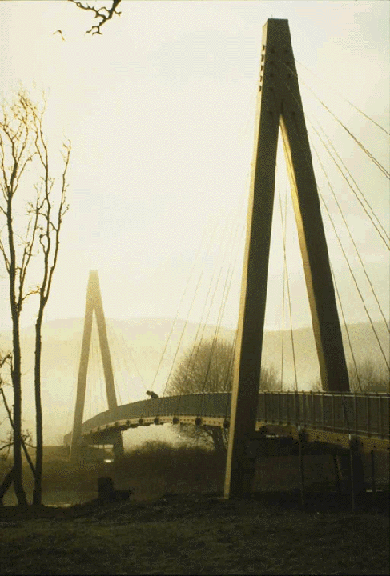About
Consultancy
Tourism
 The
topic of a second bridge for Hayling Island first came up, as far as
I was concerned, in the mid 1990s. At the time I proposed that it be
built as a second generation technology demonstrator following the success
of a bridge built entirely of composite materials at Aberfeldy in Scotland.
The bridge is over the River Tay and joins the two halves of Aberfeldy
Golf Course. The Aberfeldy bridge has a sixty four metre span; the Hayling
Island Bridge would need a span approximately four times greater.
The
topic of a second bridge for Hayling Island first came up, as far as
I was concerned, in the mid 1990s. At the time I proposed that it be
built as a second generation technology demonstrator following the success
of a bridge built entirely of composite materials at Aberfeldy in Scotland.
The bridge is over the River Tay and joins the two halves of Aberfeldy
Golf Course. The Aberfeldy bridge has a sixty four metre span; the Hayling
Island Bridge would need a span approximately four times greater.
My reasoning was, among other things, that it would be a technical tourist attraction. The site would be alongside the present bridge at Langstone, between Havant and Hayling Island. Within fifty miles are the Universities of Surrey, Southampton, Brighton and Portsmouth; all having civil engineering Departments and an interest, involvement, in composite materials. That is without the Universities in London and Oxford, which are only a few more miles away. In addition, Professor Len Holloway, Professor of Civil Engineering Composites at the University of Surrey had been carrying out research with the Civil Engineering Consultants, responsible for the Aberfeldy bridge, for many years.
Moreover, both of the International Civil Engineering Companies, with which I was discussing the idea are also with fifty to sixty miles of Langstone.
After
all, if you have clients flying into Heathrow, Gatwick, Stanstead, Luton,
etc., where would you rather taken them to see a new development in
bridge technology, a few hundred miles to the River Tay in Scotland,
or a few tens of miles to the South Coast of England?
An illustration of the Aberfeldy bridge is show to the right and was
borrowed from a University of Plymouth web page.
The bridge I had discussed with Civil Engineering Consultants would have been longer than the Aberfeldy bridge and, with emergency vehicle use, capable of heavier loads; a step up from it. Hence the technology demonstrator description, proposal, and the possibility of obtaining funds from Europe to partly, or fully, finance it as a result.
The
relative ease of travelling to Langstone, compared with Aberfeldy, was
an important consideration. Hence, in those discussions, the attraction
of a technology demonstrator in the South of England.
Apart
from the technical demonstration aspect the bridge there was the matter
of people visiting the area anyway, where it would have been something
of a technology tourist attraction. That was felt to be a positive factor
in seeking funding, or would have been had interest been shown locally
and a proposal and request submitted.
Since then we have had the construction of the Millennium Tower in Portsmouth, well almost; it should be completed by the next millennium. Either way, had our proposal for the Hayling Island bride at Langstone gone ahead, you would have been able to see the tower from the bridge with ease, as well as vice versa. two structural attractions within a few miles of each other and within easy sight of each other, involving completely different technologies.